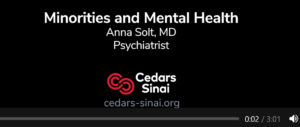 People belonging to racial and ethnic minority groups are less likely than white people to receive mental healthcare.
People belonging to racial and ethnic minority groups are less likely than white people to receive mental healthcare.
Anna Solt, MD, a Cedars-Sinai psychiatrist, said that reduced access to mental healthcare, cultural stigmas and even stereotypical beliefs within a culture can cause barriers to mental health treatment.
“There are stereotypes within Hispanic communities, for example—women are seen as being dramatic and often anxious or nervous, and for men, it’s normal to have a temper or be irritable—that doctors sometimes buy into. But these can be symptoms of mental illness that tend to be overlooked,” said Solt.
Mental illness affects more than 1 in 5 adults in the U.S., according to the Centers for Disease Control and Prevention, and the prevalence of mental illness varies from one demographic to another, Solt said.
During Minority Mental Health Awareness Month in July, the Cedars-Sinai Newsroom spoke with Solt about mental health services and barriers for minorities, and strategies for getting help.
How many people from minority communities receive mental health services?
People belonging to minority groups are less likely to receive mental healthcare. For example, of the people with mental illness, 48% of white people receive mental health services whereas only 30% of Black and Hispanic populations and 22% of Asian American populations receive treatment. There are also differences between the type of services that minorities seek. White people, Native American people and Native Alaskan people are more likely to receive outpatient services and be accepting of psychiatric medication. Inpatient services are more utilized by Black people, and as mentioned, Asian Americans are the least likely to seek mental health services.
What barriers keep minorities from accessing treatment?
In general, it is mental illness stigma, a lack of understanding between the patients and their families that a certain symptom is a sign of mental illness, and the lack of diversity and cultural competence among the healthcare professionals who treat patients. There are also financial barriers, such as accessing medical insurance, and language barriers.
How can we change the conversation about mental health?
When people are reluctant to seek mental healthcare, I think the most helpful thing to do is to educate them. Many people believe that some symptoms of mental illness—being dramatic or upset and trying to calm your feeling with alcohol or other substances—are normal. But it’s very important to educate people about mental illness and let them know that this is not something that you could just get over on your own. You need an evaluation, you need a diagnosis, and you may need medication or therapy.
How can people access mental health services?
If someone is in crisis, they should be calling 911 or the suicide prevention and crisis lifeline, which is now 988. That is what people are supposed to do. If it’s not a crisis, I suggest that people ask their primary care physician for a referral to a mental health specialist. There are also online resources like the National Alliance of Mental Illness, the National Institute of Mental Health, or the California government webpages that provide mental health programs and services.
Source: /Newswise
Image: Freepik


































